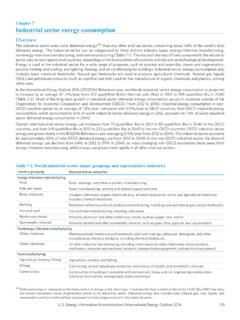Transcription of UK Energy Statistics, 2019 & Q4 2019
1 Page 1 of 16 PRESS NOTICE Date: 26 March 2020 STATISTICAL PRESS RELEASE UK Energy Statistics, 2019 & Q4 2019 Energy Trends and Energy Prices publications are published today 26 March 2020 by the Department for Business, Energy and Industrial Strategy. The publications cover new data for the fourth quarter of 2019 (October to December) and thus provisional annual data for 2019. This press release focuses mainly on the 2019 annual data.
2 Energy Trends covers statistics on Energy production and consumption , in total and by fuel, and provides an analysis of the year on year changes. The key points from 2019 are: total Energy production was per cent lower than in 2018. This fall, the first since 2014, follows four consecutive annual rises, was due to rises in output from oil, bioenergy and waste, wind, solar and hydro being offset by falls from coal, gas and nuclear. The output from bioenergy and waste and wind, solar and hydro is now nearly 15 times higher than coal, notable as coal output was greater as recently as 2012. total primary Energy consumption for Energy uses was per cent lower than in 2018. However, when adjusted to take account of weather differences between 2018 and 2019, primary consumption fell by per cent.
3 Final Energy consumption (excluding non- Energy use) was per cent lower than in 2018. On a seasonally and temperature adjusted basis it is estimated to have fallen by per cent with falls in the domestic, industrial and transport sectors but a rise in the services sector. Of electricity generated in 2019, gas accounted for per cent whilst coal accounted for only per cent. Renewables share of electricity generation increased to per cent in 2019 - a record high - with 119 TWh electricity generated from renewable sources, as a result of increased capacity. Nuclear generation s share declined compared to 2018, due to reactor outages and required maintenance. Page 2 of 16 Renewable electricity capacity was GW at the end of 2019, a per cent increase ( GW) on a year earlier.
4 Low carbon electricity s share of generation increased from per cent in 2018 to a record high of per cent in 2019, driven by growth in renewable generation due to increased capacity. Other highlights from 2019 include: Imports in 2019 were per cent lower than in 2018, whilst exports fell by per cent. As a result, net import dependency fell back from per cent to per cent. Demand for oil fell for the second consecutive year as a result of depressed demand for transport fuels, notably diesel. Supply of gas to the UK saw a shift in 2019 as pipeline flows fell to 60 per cent of total imports as volumes of Liquefied Natural Gas more than doubled. Exports remained low and 2019 was only the fourth year in the series that the UK exported less than 100 TWh. Coal production was 16 per cent lower than in 2018, and at a record low level, due to further contraction of surface mining and lower demand for electricity generation.
5 Imports of coal in 2019 were 33 per cent lower compared to 2018. Coal stocks were broadly similar to last year. Gas demand in 2019 was stable on the year before at 876 TWh, with a small increase in gas use for electricity generation offset by a small decrease in final consumption . total electricity generated in 2019 was TWh, a decrease of per cent compared to 2018 ( TWh). More than a third ( per cent) of UK generation came from renewable sources in 2019, driven by high generation from wind, solar and bioenergy sources, while coal generation decreased substantially, pushing fossil fuels to an all-time low share of the generation mix at per cent. Energy Prices covers prices to domestic and industrial consumers, prices of oil products and comparisons of international fuel prices.
6 The key points from 2019 are: Average annual household Energy bills (based on updated fixed consumption figures of 3,600 kWh per annum for electricity and 13,600 kWh per annum for gas) across all payment types were 1,289 in 2019, an increase of 55 (up per cent) compared to 2018. Average electricity bills were 39 higher and gas bills 16 higher than the previous year. Based on actual annual household consumption , combined Energy bills increased by per cent in cash terms (to 1,155 in 2019 from 1,100 in 2018) and increased by per cent in real terms (to 987 in 2019 based on 2010 prices). For more detailed information on methodology, quality assurance and use of the data, please refer to the methodology notes available by Energy sector on the BEIS section of the website at: Page 3 of 16 The March 2020 edition of Energy Trends also includes articles on: Trends in trade of Liquefied Natural Gas in the UK and Europe Wind powered electricity in the UK International comparisons of household Energy efficiency The items below which previously would have been published in Energy Trends now form part of the March 2020 edition of the Energy Prices publication: Domestic Energy bills in 2019: The impact of variable consumption Domestic prices.
7 Methodology note The following Energy and climate change statistics are also published today 26 March 2020, by the Department for Business, Energy and Industrial Strategy: Greenhouse Gas emissions, 2019 provisional figures Solar Photovoltaics deployment, February 2020 Page 4 of 16 total Energy : 2019 total Energy - Production 0501001502002503003501998200020022004200 6200820102012201420162019 pMillion tonnes of oil equivalent (1) Nuclear and wind, solar & natural flow hydro electricity total production in 2019 was million tonnes of oil equivalent, per cent lower than in 2018. This fall the first since 2014, follows four consecutive annual rises, is due to rises in output from oil, bioenergy and waste, wind, solar and hydro being offset by the continued decline in UK coal production and reduced output from gas and nuclear.
8 Production of oil rose by per cent to the highest level since 2011, due to new production from the Clair Ridge field which opened at the end of 2018, whilst gas fell by per cent due to the closure of the Theddlethorpe terminal in 2018, as well as reduced output at several large gas terminals during 2019. Production of bioenergy & waste rose by per cent between 2018 and 2019 to a record million tonnes of oil equivalent, driven by an increase in plant biomass capacity. Primary electricity output fell by per cent between 2018 and 2019, within which nuclear output fell by 14 per cent to the lowest level since 2008, due a series of prolonged outages throughout the year at Dungeness B and Hunterson B, reducing the UK s operational nuclear capacity, whilst output from wind, solar and hydro rose by 10 per cent, to a record high level, due to increased wind and solar capacity.
9 total Energy quarterly tables ET are available on the BEIS section of the website at: 2019 Million tonnes of oil equivalent Percentage change on a year earlier total production Oil + Natural gas Primary electricity(1) Bioenergy & waste + Coal Page 5 of 16 total Energy : 2019 total Energy consumption (1) 1801902002102202302402502000200220042006 200820102012201420162019 pMillion tonnes of oil equivalent0 (1) total inland consumption on a primary fuel input basis (seasonally adjusted and temperature corrected annual rates). Final Energy consumption (excluding non- Energy use) was per cent lower than in 2018. Domestic consumption fell by per cent with lower demand in quarter 1 as a result of warmer temperatures compared to 2018 during the Beast from the East weather storm.
10 On a temperature corrected basis, final Energy consumption fell by per cent, with domestic consumption also down by per cent. When examining seasonally adjusted and temperature corrected annualised rates: total inland consumption on a primary fuel input basis was million tonnes of oil equivalent in 2019, per cent lower than in 2018. Between 2018 and 2019 coal consumption fell by 26 per cent to a record low, whilst oil consumption fell by per cent but gas consumption rose by per cent. Bioenergy and waste consumption rose by per cent, whilst primary electricity consumption fell by per cent, within which nuclear fell by 14 per cent but wind, solar and hydro rose by 10 per cent. total Energy quarterly tables ET are available on the BEIS section of the website at: 2019 Million tonnes of oil equivalent Percentage change on a year earlier total Energy consumption Unadjusted Seasonally adjusted and temperature corrected annual rate Final consumption : unadjusted temperature corrected Page 6 of 16 COAL.


















